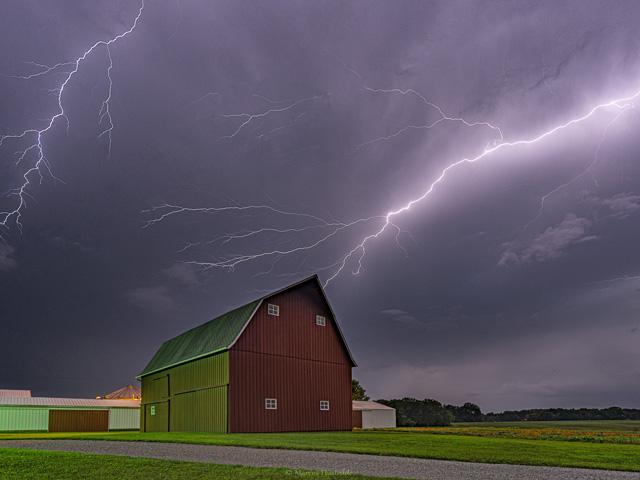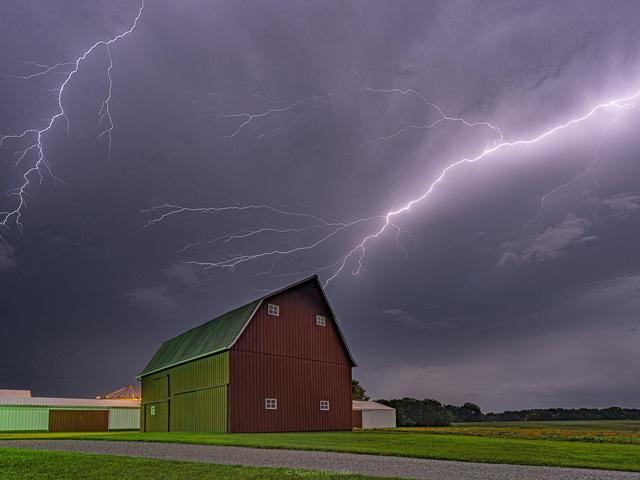Ag Weather Forum
Weather Outlook Through Summer 2024 Sees El Nino Switch Back to La Nina
It's not unprecedented, but it is very rare. After going from three straight La Nina winters to an El Nino for the 2023-2024 winter, a quick change back to La Nina for summer 2024 is a likelihood, if not a guarantee.
Historically, a strong El Nino during the winter usually leads to a La Nina in the following summer or fall. In fact, in the records going back to 1950, when a strong El Nino of this magnitude occurs, it is followed by two straight winter seasons of La Nina. The rate at which El Nino transitions to La Nina will be crucial in the weather outcome for the 2024 growing season, and there is significant uncertainty for the seasonal forecast. If you would like to skip the weather discussion, you can check out regional comments for the season ahead here: https://www.dtnpf.com/… .
ENSO FLIPPING BACK AGAIN
A lot of talk in the weather world will be about the decay of the current El Nino (above-normal sea-surface temperatures in the tropical Pacific Ocean) during the spring and the likelihood of La Nina (below-normal sea surface temperatures) developing during the summer or fall as the El Nino Southern Oscillation (ENSO) index flips from a positive (El Nino) to a negative (La Nina).
The Pacific Ocean had three straight seasons of La Nina from the 2020-2021 Northern Hemisphere winter to the 2022-2023 winter season. That abruptly changed in spring of 2023 as the trade winds relaxed and the ocean surface warmed, eventually getting very close to a full 2 degrees Centigrade above the climatological average by the fall. That historic mark has only been reached during five seasons since 1950 -- in 1965-66, 1972-73, 1982-83, 1997-98 and 2015-16. This year has fallen just shy but has shared some similarities to these other "super Ninos" with an incredibly warm December and an arctic burst in mid-January.
Historically, after these "super Ninos" comes two straight seasons of La Nina, though their intensity varies from weak to strong, and the transition from El Nino to La Nina can be drastic or gradual. The way that ENSO flips this year will have a dramatic effect on the sensible weather throughout the spring and summer seasons, leading to interesting developments in the weather patterns for 2024.
We have likely reached the peak of El Nino in mid-January, and all global climate models show a decay of El Nino in spring 2024 toward somewhere between neutral or strong La Nina for summer. But the models decay the ocean temperatures in a variety of ways and speeds. The American CFS climate model has had an impressive streak at developing ENSO over the last three to four years. Though the magnitudes have been aggressively high and low, it was the first model to develop La Nina for winter 2020-21, harken the return to La Nina in 2021-22 when other models did not, and the first to bring about a strong El Nino for 2023-24. Coincidentally, it was also the first global model to suggest La Nina would develop during the summer of 2024, which has been a consistent feature of that model for several months. Other models are also following suit but are doing so at different speeds and intensities.
The CFS is very aggressive at destroying El Nino during spring and setting up a moderate La Nina during summer. Looking at the historical records, only one period comes close to having this whiplash effect between El Nino and La Nina characterized in the same way. The early to mid-1970s had a streak of two La Ninas followed by a super El Nino in 1972-73, followed by a strong La Nina that quickly developed in summer '73. It was the first in a string of three straight La Nina winters.
P[L1] D[0x0] M[300x250] OOP[F] ADUNIT[] T[]
Normally, long-range weather forecasters would use such a period as an analog (comparable signal or weather pattern) when building the seasonal forecast for the coming spring and summer seasons. However, while ENSO may be the biggest driver of global climate and weather, it's not the only one. Surface temperatures of the other world oceans and other more sub-seasonal weather phenomena also drive weather. Consequently, the other ocean temperatures around the world in 1973 are nowhere near what the forecasts are for 2024, and those sub-seasonal weather phenomena are unpredictable beyond the next four to five weeks. Therefore, 1973 was not used as an analog year in the DTN forecast, and there may not be a truly good analog to use this year.
The whiplash may be too anomalous for history to give us a confident basis for the future. However, there are some years that do look close to or show enough similarities to use as analogs for the forecast. Two of those include the super Nino years of 1998 and 2016 and a more contemporary year, 2020. In those years, La Nina built into the Pacific during the summer, though it was slower than the current CFS forecast in 2016 and 2020. Other years such as 2005 and 2007 rank high on the list as well. While each year has its drawbacks in drawing direct comparisons to what 2024 will bring, blending them together can hopefully show us some signals for what impacts may or may not be important for the year ahead.
CURRENT DROUGHT IS A FACTOR
We cannot start talking about the future without acknowledging what the current situation is. 2023 ended with a large area of drought in the middle of the country, especially around Iowa and eastern Nebraska as well as the Lower Mississippi and Tennessee river valleys. In January, those areas and others in drought between the Rockies and Appalachians have gotten some help from large storm systems, but the drought remains. Some of these areas had rainfall deficits in 2023 that exceed 10 inches, so drought will be a continuing struggle going into spring.
That is not to say the drought will look the same in spring as it does now in the middle of winter. The rest of the winter season favors a southern storm track thanks to the continued El Nino. Areas along the Gulf Coast, which include the large drought areas in the Lower Mississippi and Tennessee valleys, are likely to see continued improvements over the next couple of months. Areas of the Central and Southern Plains are more likely to see continued drought reduction in the coming months as well, and the drought that remains in this region is rather fragmented anyway.
However, with a southern storm track also comes the likelihood of drier weather in the Midwest and Ohio valleys. Though drought may have been reduced in January, we could see it return or deepen going into spring. Parts of the Northern Plains have also been drier as of late, which could bring drought conditions to these areas if spring storms fail to materialize.
SPRING WEATHER VERY UNCERTAIN
Speaking of spring, the rapid transition out of El Nino does not give a lot of confidence to the forecast temperature and precipitation patterns across the U.S. The speed at which El Nino degrades will determine how much influence it will continue to have over the pattern going through April and May. A faster dive in the Pacific Ocean sea-surface temperatures will mean more small-scale patterns will gain influence over the weather more quickly, which are hard to predict more than just a couple of weeks out.
If anything stands out in the overall pattern based on historical years when ENSO was transitioning from El Nino to La Nina, it might be that the Ohio Valley and general vicinity stay unusually dry while those in the Plains end up with better rainfall on average. That is not a hard-and-fast rule, but it is an overall trend. Long-range models seem to bear that out to some degree as well.
If drought cannot be alleviated in the central Corn Belt and Delta areas, then they may not have a lot of hope during the spring. Crops may get planted on time and with little effort or stress, but early development of crops could be more at risk. Risks to transport on the Mississippi River and other major rivers could be at further risk as well. On the opposite end, good precipitation over the winter and continued good rainfall in the spring may lead to more difficult planting conditions in the Western Corn Belt. However, the early growth period could be a favorable one.
HISTORICAL PERSPECTIVE FOR SUMMER 2024
That leads us to what the conditions may be like during the heart of the growing season in 2024. In all honesty, there is no confident way to judge what the weather conditions will be like for summer. However, if we take the forecast of a developing La Nina and a few years that may turn out similar, there is one concerning trend -- a persistent upper-level ridge over the eastern half of the U.S.
A ridge tends to limit precipitation while increasing temperatures. Given the earlier-mentioned concerns for a drier Eastern Corn Belt through the spring, a large ridge of heat and dryness may exacerbate drought and degrade growing conditions during the most important time of the year.
In contrast, a general trough in the western U.S. may also be preferred more often than not, which would keep the Plains and Western Corn Belt in a more active pattern. It may not necessarily be cooler, but any precipitation would limit the overall heat stress that could be possible.
Of course, when talking about a seasonal forecast, giving general ideas about the overall conditions negates the nuance that weather actually provides during a season. For example, though it may end up warmer and drier than normal in the Eastern Corn Belt, rains that do come could be timely and enough to produce a good crop, even with drought conditions in the region. In contrast, though the seasonal outlook may suggest overall good conditions in the Western Corn Belt, it does not mean that regional drought cannot and will not develop, or that the rainfall will occur at the right time. Rain early and late in the season may give the region the overall impression of a wet season, but a three-week hot-and-dry period in July could be a disaster. Therefore, with this much uncertainty in the forecast due to the fall of El Nino and the building of La Nina, it is hard to gauge with any confidence how this season will turn out for crop production, livestock conditions, or transportation.
To find more weather conditions and your local forecast from DTN, head over to https://www.dtnpf.com/….
John Baranick can be reached at john.baranick@dtn.com
(c) Copyright 2024 DTN, LLC. All rights reserved.






Comments
To comment, please Log In or Join our Community .